全文HTML
--> --> -->目前解决此类加载技术问题的方法主要包括以下几方面. 1)设计直径更大的均匀光斑加载, 这也要求CPP刻蚀深度更深, 存在设计和加工匹配的难题; 同时考虑到刻蚀后光束近场调制造成的光学元件损伤的问题, 激光输出能量需要大幅降低; 焦斑增大后功率密度进一步降低, 这将造成直接驱动的加载压强无法达到预定值. 2)设计多个均匀光束在靶面上进行交叠, 从而增大光束均匀分布的范围, 这一过程对激光瞄准注入精度要求非常高, 通常很难达到. 3)采用间接驱动方式[6,14,15], 可设计直径更大的柱腔加载, 这一方面的物理实验开展的较少. 间接驱动实验中, 激光在黑腔中转换为X射线, 进而烧蚀平面靶, 因而驱动效率会明显降低. 考虑可行性与实验周期, 采用间接驱动方式, 设计合适的腔型及激光参数开展相关物理实验, 为后续实验提供基础.
本文主要研究强激光间接驱动金属材料动态破碎过程的加载技术. 通过IRAD数值模拟设计实验所需的半柱腔, 并通过物理实验获得此腔型下多个激光能量点、脉宽2 ns和3 ns条件下辐射峰值温度和波形. 同时, 利用流体模拟方法给出1, 2, 3 ns辐射波形下冲击加载波形. 动态物理实验给出峰值辐射温度为138 eV下间接驱动加载下层裂的物理图像及自由面速度. 经分析, 间接驱动的加载一维区达到2 mm, 平面性优于5%. 研究结果为后续物理实验奠定了良好的基础.
2.1.实验设计
实验在神光大型激光装置上完成, 实验装置示意图如图1所示. 实验利用上四路纳秒激光注入半柱腔中产生X射线并对锡平面靶进行冲击加载; 在一定的时间延迟后, 利用皮秒激光作用产生微焦点、高能X射线对加载后样品成像[13], 并采用成像板(IP)记录图像;同时利用光子多普勒干涉仪(PDV)对界面速度进行诊断[16]. 高能X射线成像及PDV测速的细节内容已在文献[13,16]中报道, 这里不再赘述.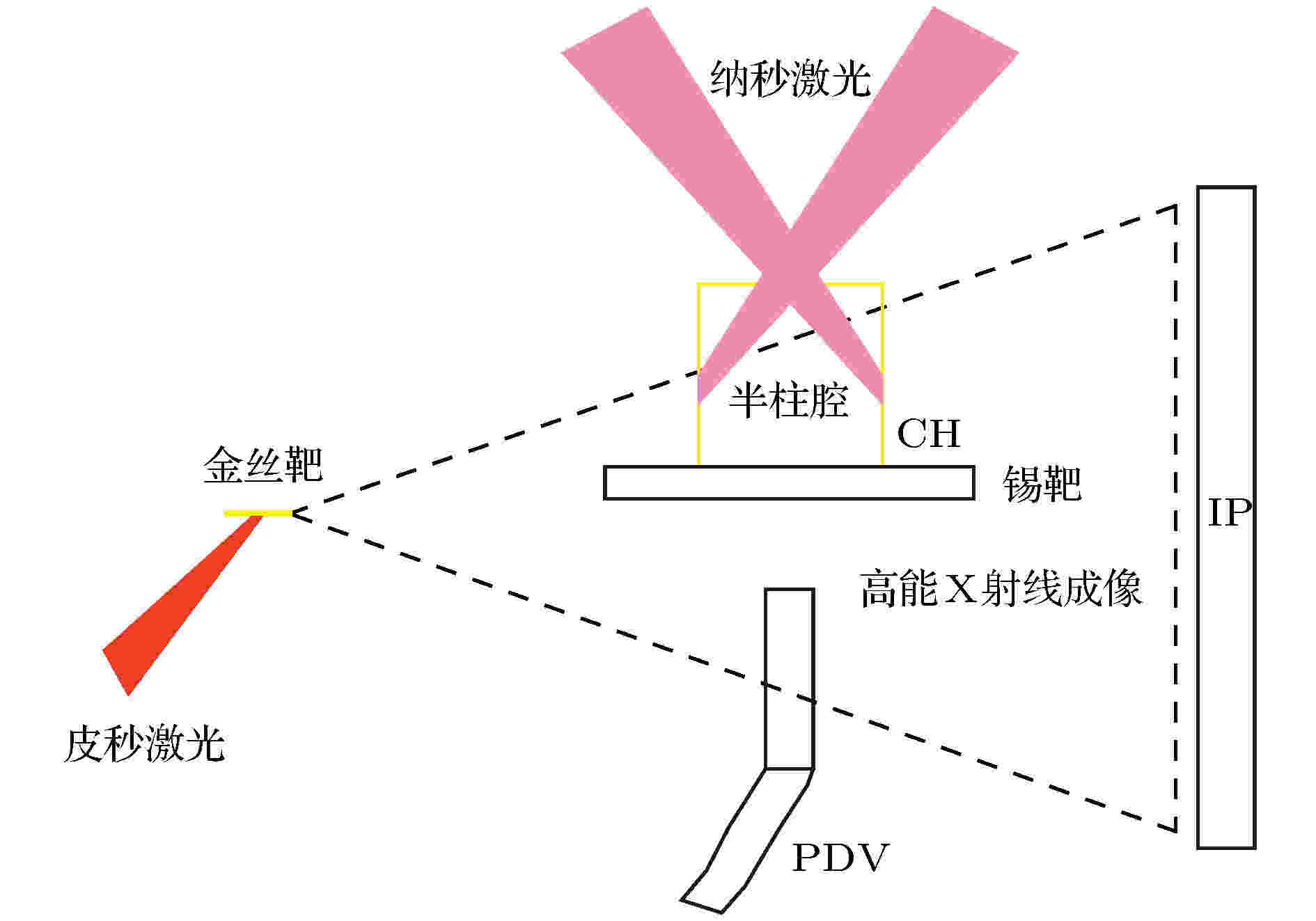 图 1 激光间接驱动冲击加载物理实验示意图
图 1 激光间接驱动冲击加载物理实验示意图Figure1. The schematic view of indirect driving shock wave experiments via lasers.
实验中半柱腔为Au腔, 其直径为2 mm, 腔长为2 mm, 注入口直径为0.8 mm, 腔壁厚为0.04 mm. 锡靶厚度为0.5 mm, 光洁表面, 表面粗糙度优于0.1 μm. 为了提高辐射驱动压力, 锡靶上表面粘上CH层(薄膜, 只含C, H元素), 其厚度为10 μm. 背光靶为Au丝靶, Au丝直径为20 μm, 长度为0.5 mm, Au丝放置于CH基底上. 锡靶置于靶室中心(通过靶室的外置基准定位靶室中心的一个点, 定义为靶室中心), 背光靶置于靶室中心偏北20 mm (靶室平面为赤道面, 再按实际方位分东西南北向).
纳秒激光参数为上四束激光, 激光波长为0.351 μm, 脉宽为3 ns或2 ns, CPP束匀滑后焦斑直径为0.45 mm, 实验中每发次激光能量均实测, 数值在800—4800 J范围内, 纳秒激光注入黑腔中. 皮秒激光频率为1.06 μm, 脉宽为10 ps, 能量为450 J, 聚焦光斑Φ50 μm, 注入丝靶中心. 皮秒激光与丝靶相互作用会产生微焦点、高能X射线[13,17,18], 能段范围为50—200 keV, 前期实验表明Φ20 μm丝靶产生X射线可用于高空间分辨成像, 成像空间分辨在20 μm左右. 典型发次的动态诊断实验中, 纳秒激光注入时刻提前皮秒激光600 ns.
2
2.2.理论设计
主要采用IRAD方法模拟激光注入黑腔的辐射温度和辐照均匀性[19], 模拟的半柱腔直径为2 mm, 腔长为1.0, 1.5, 2.0, 2.5 mm条件下样品处的辐射场分布; 模拟使用的激光参数为总能量6000 J(以当时激光输出最大能量为输入条件, 获取该腔型下最高的峰值辐射温度)、波长为0.351 μm、脉宽为3 ns、入射角度为50°. Multi流体软件模拟不同辐射波形下冲击加载波形, 模拟的辐射峰值温度为140 eV, 脉宽分别为1, 2, 3 ns, 输入的辐射波形为实测辐射波形中取几个特征点, 输入的靶参数为锡靶, 其厚度为0.5 mm.3.1.辐射烧蚀均匀性的模拟优化
利用IRAD软件模拟半柱腔直径为2 mm、不同腔长下样品处峰值辐射温度分布, 结果如图2所示. 在腔长为1 mm条件下, 辐射温度分布图上显示4个局域高温点且温度分布极为不均匀. 在腔长为1.5, 2.0, 2.5 mm下, 整个样品处的辐射温度分布较为均匀. 以直径为2 mm, 腔长为2 mm为例, 中心处辐射温度为152 eV, 边缘处辐射温度为143 eV, 这个辐射场的均匀性在10%以内. 辐射温度在(150 ± 2) eV区域的直径为1.5 mm, 均匀性优于2 %. 考虑到实验中存在着激光注入时束间平衡、激光等离子体效应等诸多效应影响, 实验中半柱腔尺寸设计为直径2 mm, 腔长2 mm.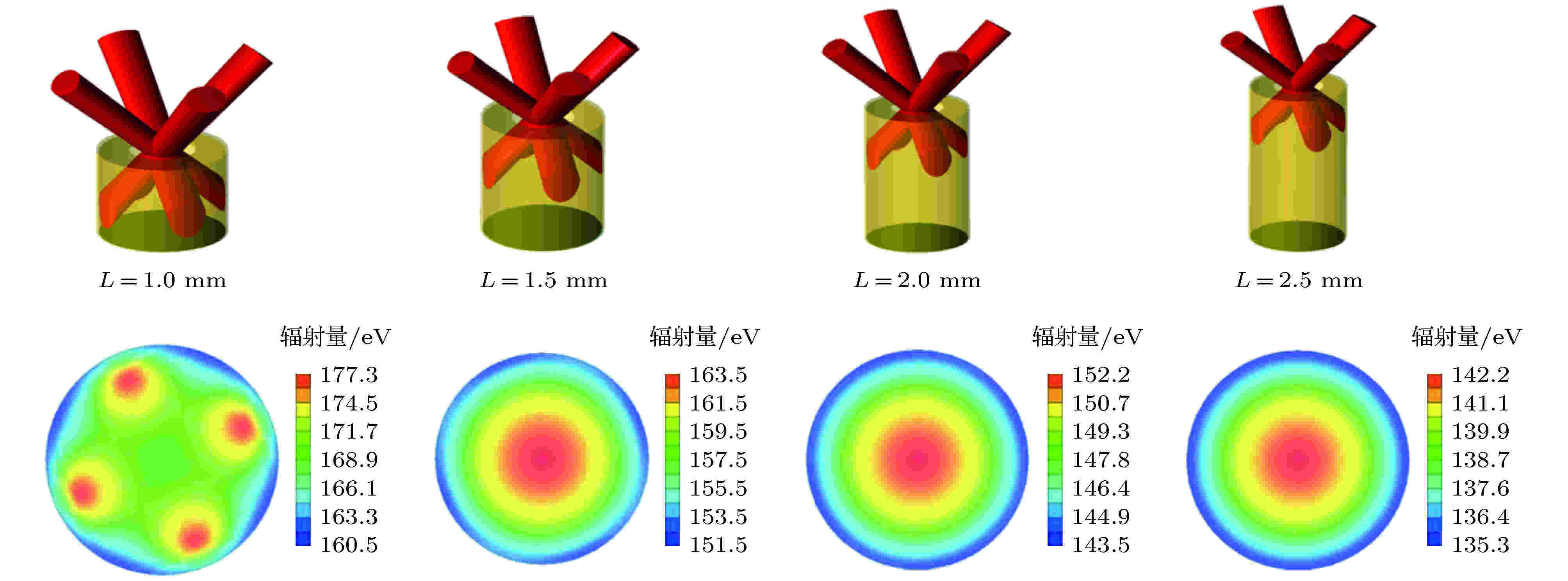 图 2 不同腔长下样品处的辐射分布
图 2 不同腔长下样品处的辐射分布Figure2. Radiation distribution in the surface of the sample for hohlraum with different lengths.
2
3.2.辐射波形
利用强激光注入半柱腔中产生均匀辐射场, 通过纳秒针孔相机监测光斑注入正常, 未形成挂边等异常注入情况. 再利用平响应X射线衍射(FXRD)获得不同能量、不同脉宽下辐射波形, 如图3所示. 在激光脉宽为3 ns情况下, 辐射温度峰值时刻为4.0 ns处, 考虑到测量信号的起点为1.1 ns, 实际辐射峰值温度时刻为2.9 ns. 峰值温度在激光能量1000 J时为138 eV, 且随激光能量提高而上升. 在2 ns情况下, 实际辐射温度峰值时刻为1.9 ns. 这里, 激光能量1314 J时辐射温度反而略比844 J低, 经分析发现此发次FXRD的信噪比较大, 但在误差范围内.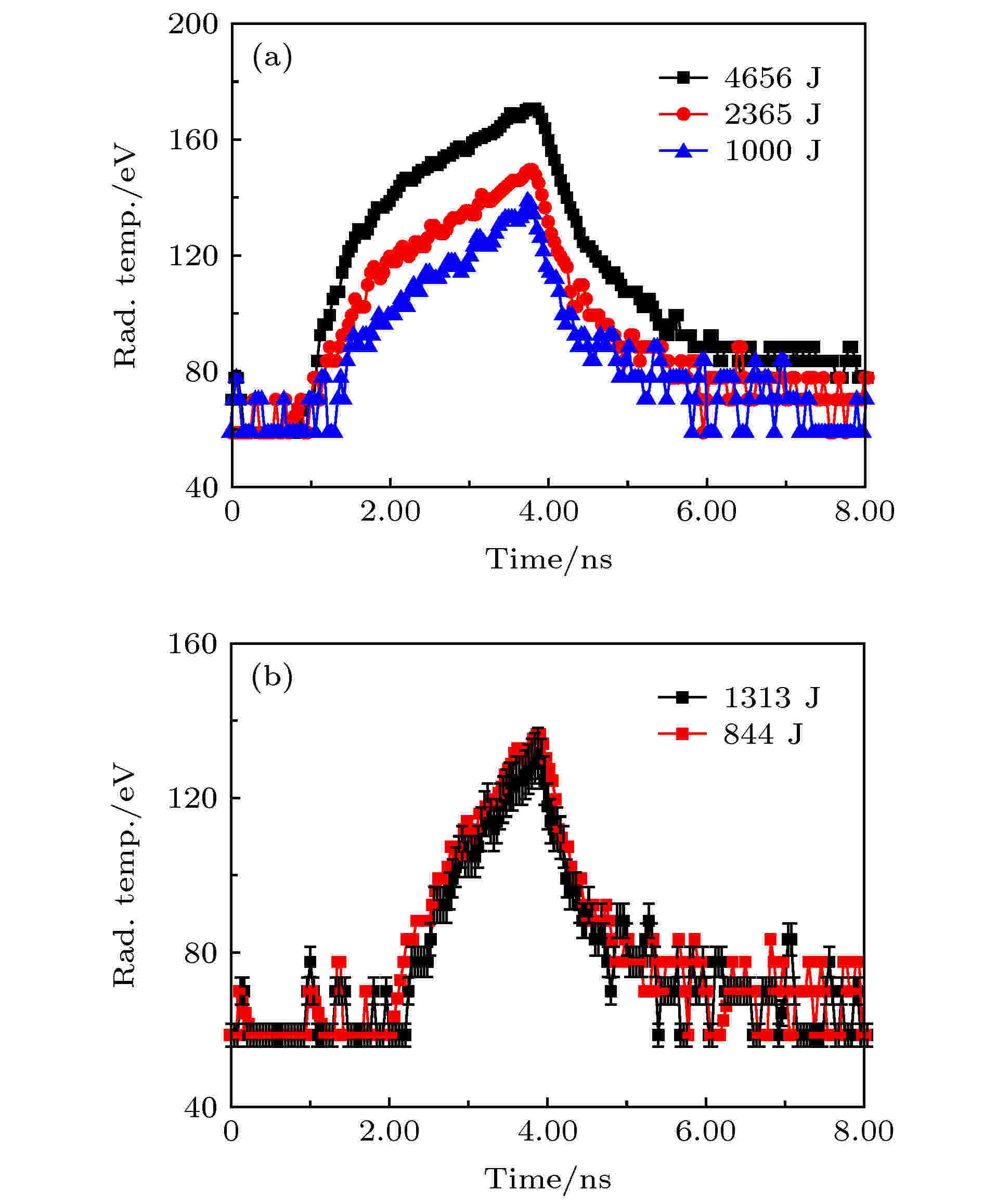 图 3 辐射波形 (a)激光脉宽3 ns; (b)激光脉宽2 ns
图 3 辐射波形 (a)激光脉宽3 ns; (b)激光脉宽2 nsFigure3. Radiation wave at different pulse duration of laser: (a) 3 ns; (b) 2 ns.
2
3.3.冲击加载波形
冲击加载波形指的是冲击波到达靶后界面时靶内压力分布情况, 此加载波形还与辐射波形与靶厚度有关. 利用一维流体软件模拟不同辐射波形下加载波形, 结果如图4所示. 从模拟结果看出, 3种不同脉宽的辐射波形下, 辐射驱动的加载波形均为三角波结构分布, 且随着脉宽增加, 峰值压力有所增加.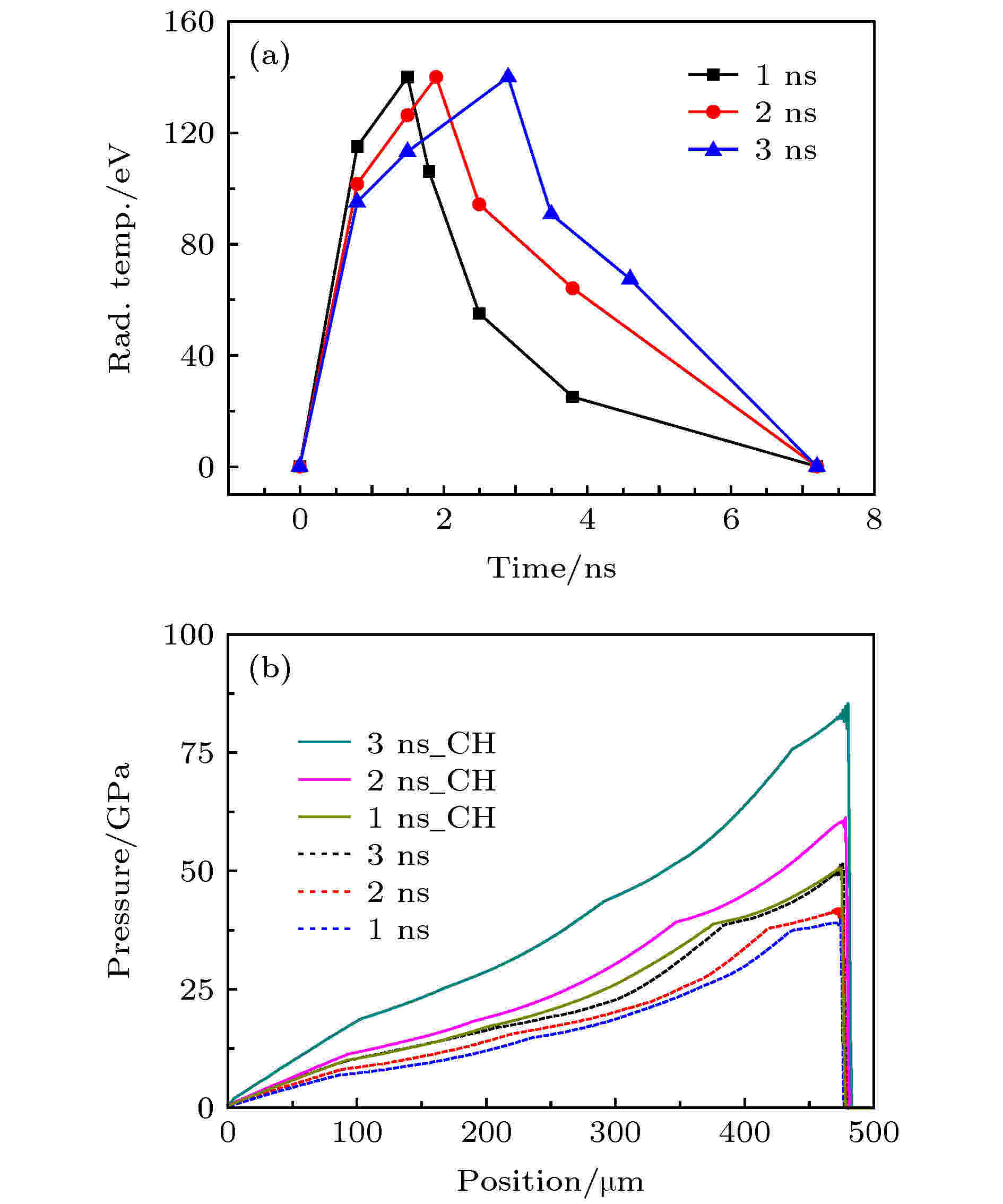 图 4 (a)不同辐射波形; (b)冲击加载波形
图 4 (a)不同辐射波形; (b)冲击加载波形Figure4. (a) Radiation wave; (b) loading shock wave at different pulse duration of laser.
为了开展更高加载压强的物理实验, 在金属靶表面贴上厚度为10 μm薄的CH层, 通过辐射烧蚀CH层进行增压. 在这种条件下, 通过Multi软件模拟获得加上CH层和未加CH层的加载压力, 进行比较, 模拟结果显示金属样品表面增加CH层能使得加载压力增大约50%.
2
3.4.动态诊断结果
实验通过上四束激光注入柱腔中, 产生辐射烧蚀加载样品; 并利用高能X射线诊断加载后样品动态破碎过程. 典型发次的实验结果(总能量为1000 J, 脉宽为3 ns)如图5所示. 动态图像清晰地显示半柱腔已经膨胀到一定程度但尚未完全解体, 在柱腔侧壁上仍能清楚地看到激光弹着点, 柱腔顶端注入口已与侧壁分离并飞行了一段距离.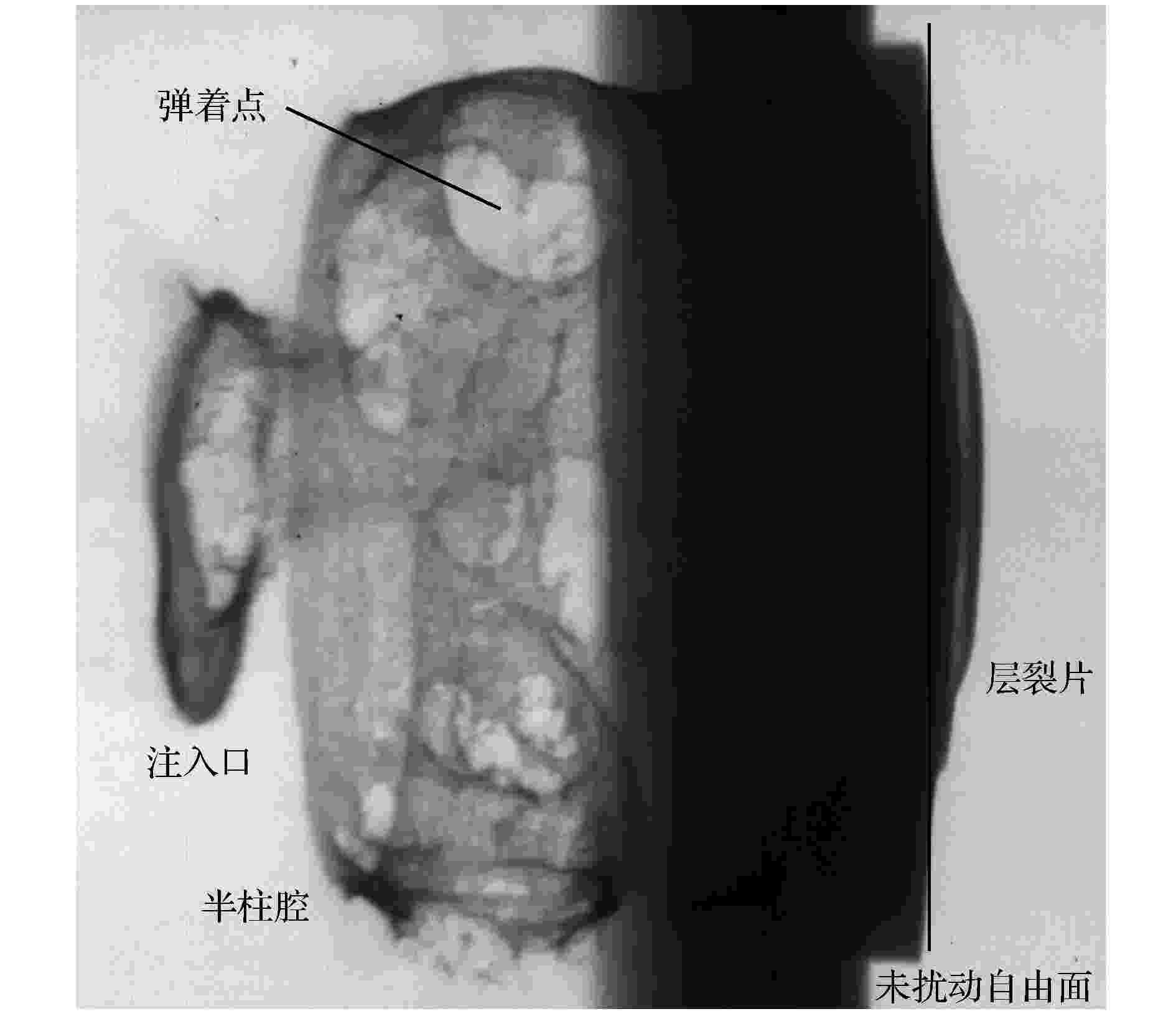 图 5 高能X射线动态诊断间接驱动的层裂过程
图 5 高能X射线动态诊断间接驱动的层裂过程Figure5. High energy X-ray radiography of spall from indirect drive by laser.
从图5还可以看到靶支撑结构和未扰动自由面位置. 冲击加载后的锡样品形成块状层裂片, 其厚度为0.06 mm, 脱离基底向前飞出, 相对未扰动自由面运动的距离为0.3 mm. 在自由面速度曲线中, 该动态过程为典型的层裂行为[20], 起跳速度为0.65 km/s, 起跳时间为131 ns, 平均运动速度为0.55 km/s. 由图中层裂片运动距离为0.3 mm、运动时间为469 ns (诊断时刻600 ns减去自由面起跳时刻131 ns), 由此推出层裂片平均运动速度为(0.63 ± 0.1) km/s, 与PDV的测试结果一致 (如图6所示).
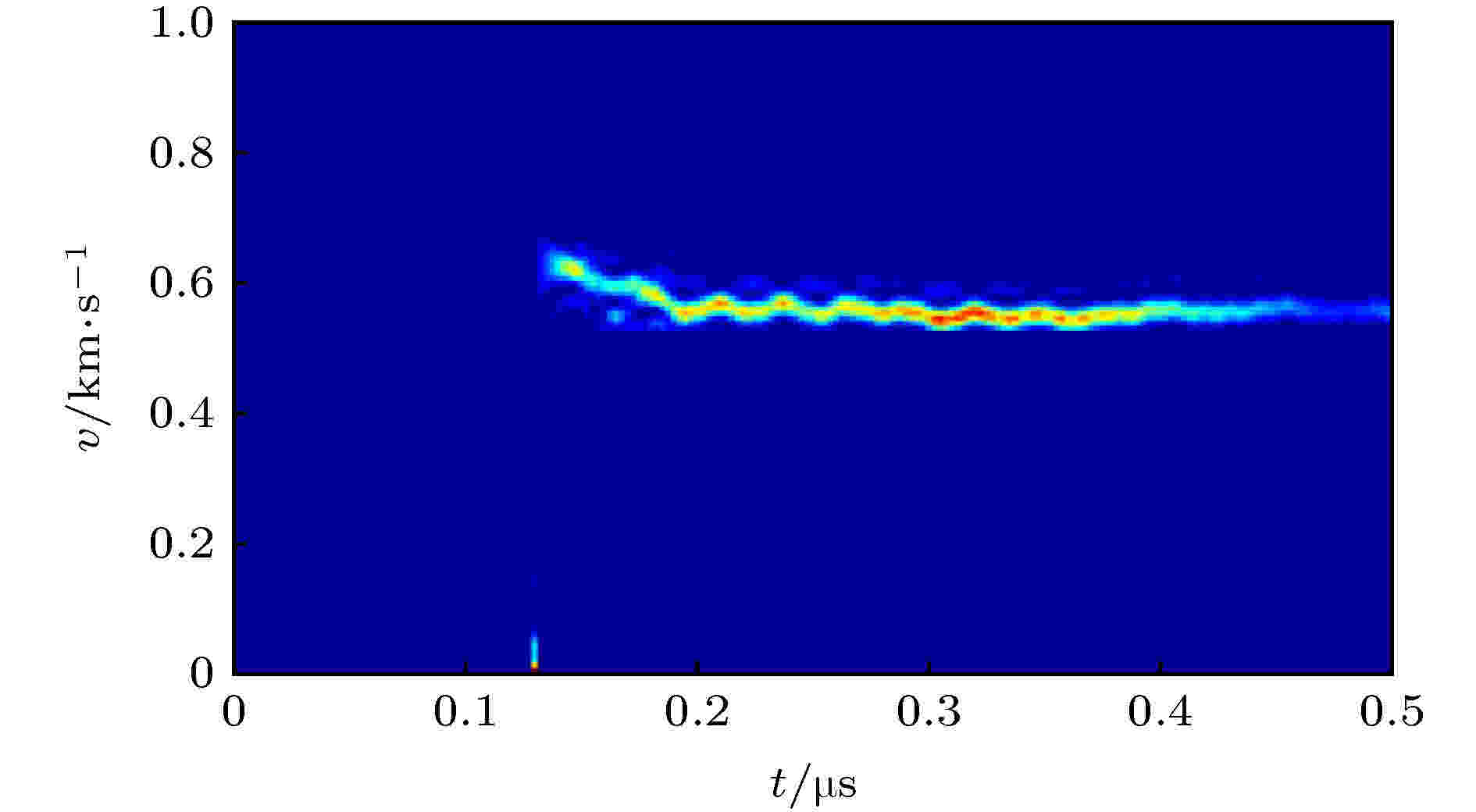 图 6 间接驱动层裂过程的自由面速度历史
图 6 间接驱动层裂过程的自由面速度历史Figure6. Velocity of free surface of spall from indirect drive by laser.
2
4.1.加载过程分析
强激光间接驱动的方式利用柱腔将激光转换为X射线, 并利用辐射烧蚀驱动对样品进行加载. 在考虑激光正常注入的条件下, 即激光注入口未堵孔和激光等离子体效应不太显著等条件, 样品处的辐射分布均匀. 通过物理实验获得实测辐射波形, 在激光脉宽为1, 2, 3 ns条件下, 辐射脉宽均与激光脉宽相当; 利用流体模拟软件给出这3种辐射波形, 辐射行为的加载波均为三角波加载, 且同一辐射温度、3种不同脉宽的辐射波形下, 辐射驱动的加载波形均为三角波结构分布, 且随着脉宽增加峰值压力有所增加. 这种加载方式与直接驱动加载方式有较好的相似性. 同时, 辐射烧蚀驱动加载中, 在激光利用效率较低的情况下, 可以通过对CH材料烧蚀实现对样品增压.在激光惯性聚变过程研究中, 因聚变过程在数ns时间范围内, 只用考虑辐射烧蚀效应对加载过程的影响; 而在激光直接驱动材料动态烧蚀过程中, 激光作用产生的等离子体会向外膨胀并飞散, 不用考虑约束的等离子体对加载过程的影响; 而利用间接驱动加载材料动态过程研究中, 时间尺度在μs量级, 同时在实验中观察到数百ns后金腔仍未完全解体, 这须要考虑到腔内约束的等离子体的影响, 而这一方面的影响目前还难以用现有的流体力学软件模拟. 进一步的研究需要通过实验测量冲击波的波形, 对动力学状态进行定标.
2
4.2.平面性分析
在考虑激光正常注入的条件下, 由IRAD模拟给出间接驱动的样品辐射分布在直径2 mm范围内均匀性优于10 %; 辐射温度在(150 ± 2) eV区域的直径为1.5 mm, 均匀性优于2 %. 这一加载过程可能受到束间平衡、等离子体堵孔及激光等离子体效应等影响, 因而须要利用动态诊断结果来判定加载一维加载大小及平面性. 本研究在层裂片头部区域选取一维平面区, 并在此区段内选取多个点来评估加载平面性. 选取的一维区大小为1.5 mm, 多个点统计获得平面性为5 %, 此时获得的一维区为后界面加载一维区.在辐射烧蚀样品表面上, 辐射驱动的一维区分布需要考虑边侧稀疏波对冲击波在靶内传输过程中的影响, 因此在由诊断图像得到的加载一维区基础上, 需加上两侧的边侧稀疏波影响的区域. 两侧的边侧稀疏影响区域为锡材料的声速与冲击波在靶内传输的时间的乘积. 锡材料的声速为2.61 km/s, 冲击波在靶内传播时间由速度历史结果给出为131 ns. 按此估算, 两侧的边侧稀疏影响区域总共为2 × 2.61 km/s × 131 ns = 0.68 mm, 辐射驱动面的一维区大小估算为1.5 mm + 0.68 mm = 2.18 mm, 略大于柱腔直径2 mm. 实际上, 半柱腔直径为2 mm, 因此加载区域只能限定为2 mm. 这一结果说明辐射驱动面的一维区在Φ2 mm内分布较为均匀.
感谢中国工程物理研究院激光聚变研究中心靶制备部门的同事及上海神光II升级激光装置运行团队的合作.
